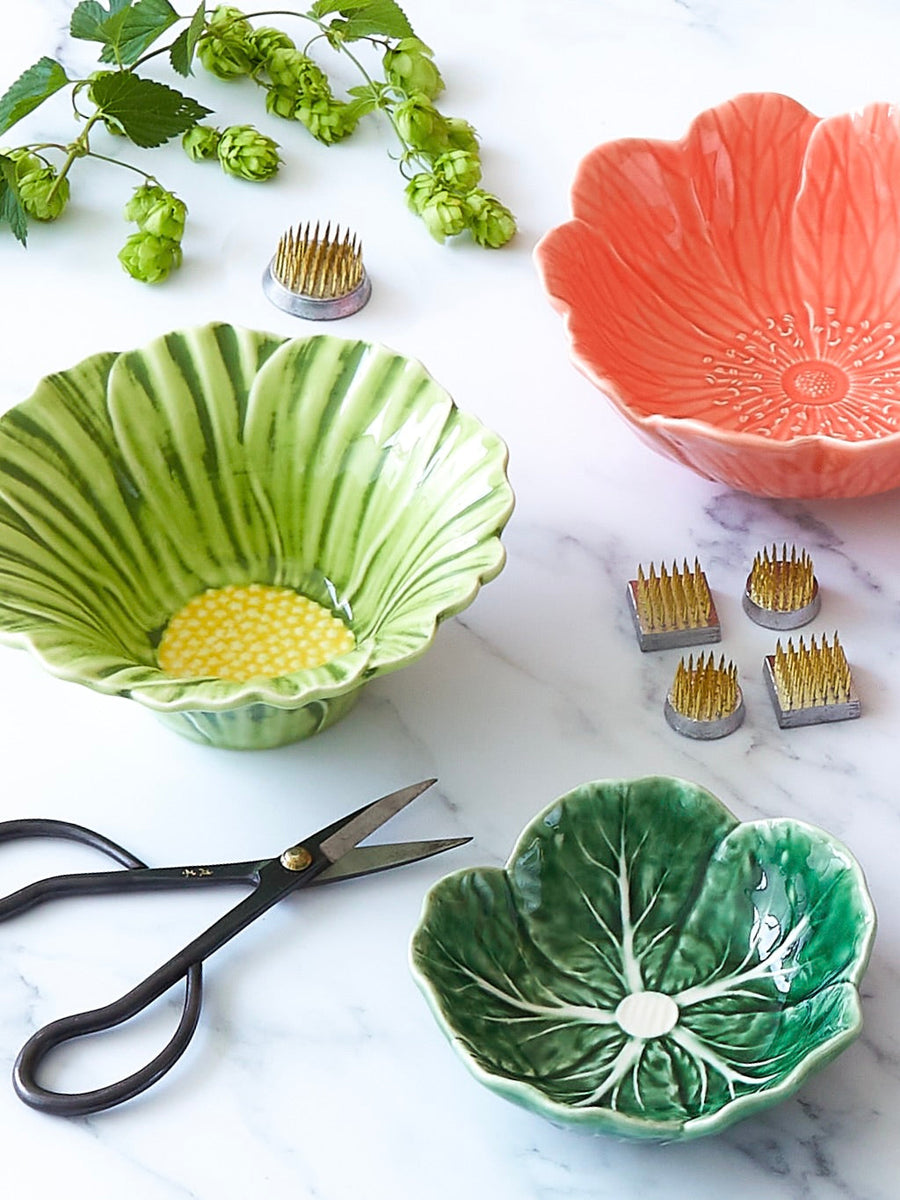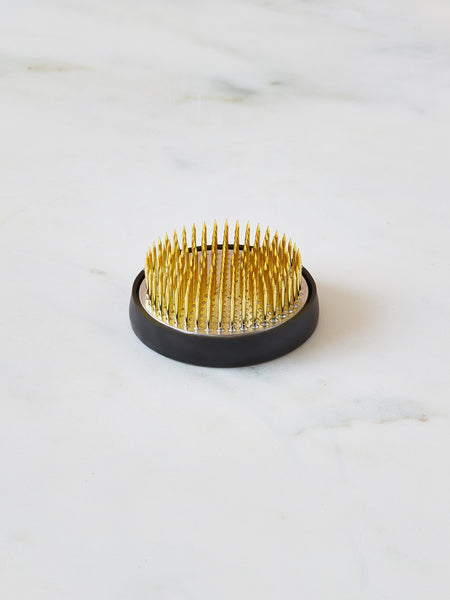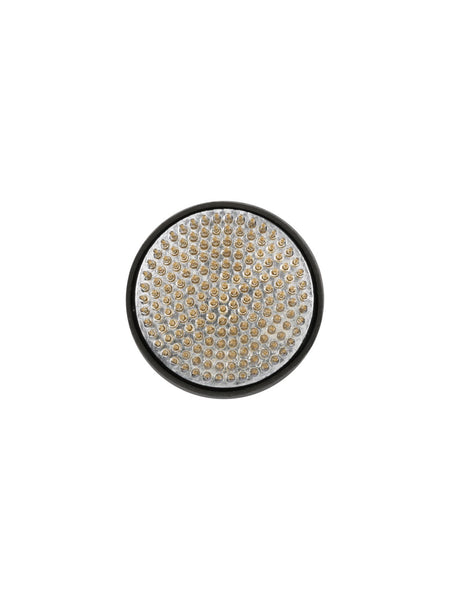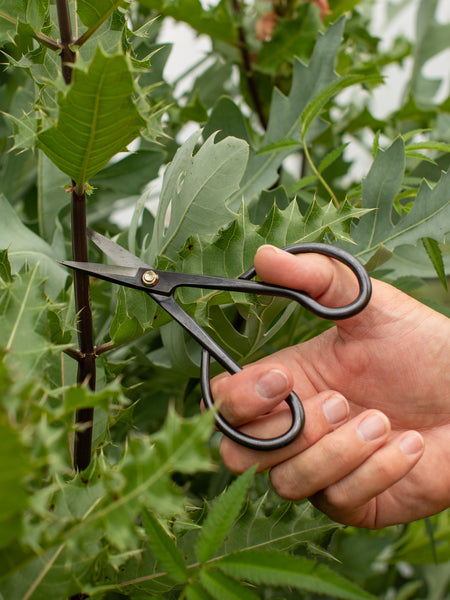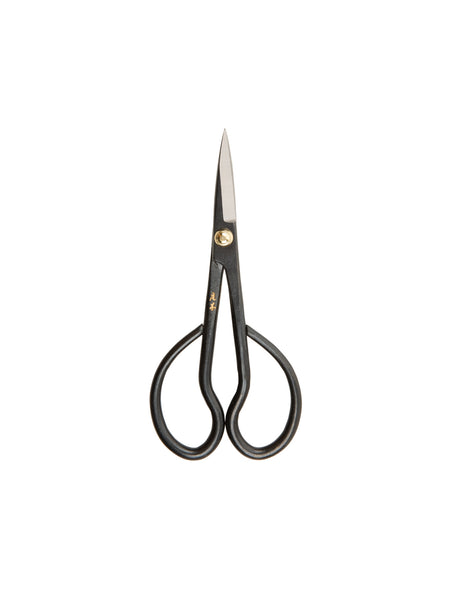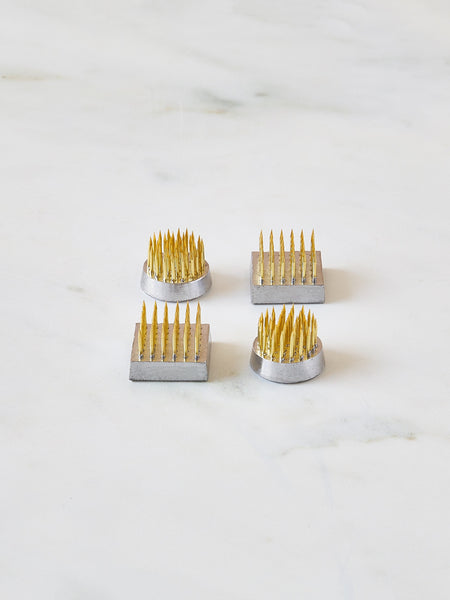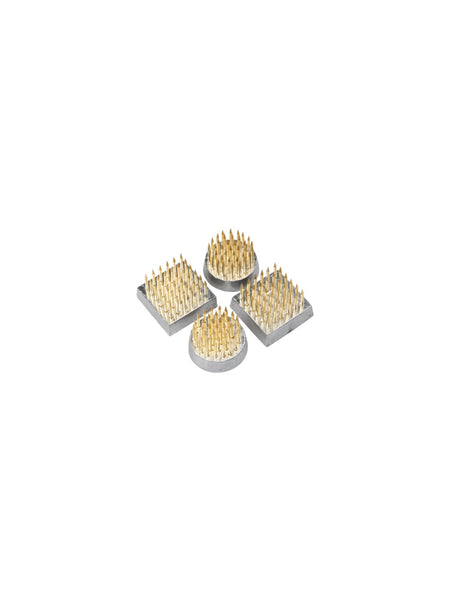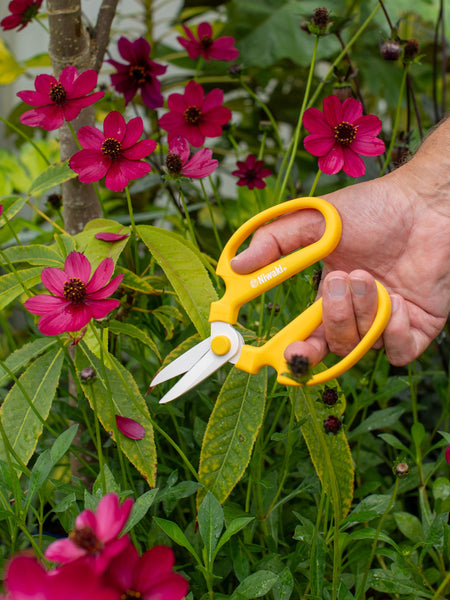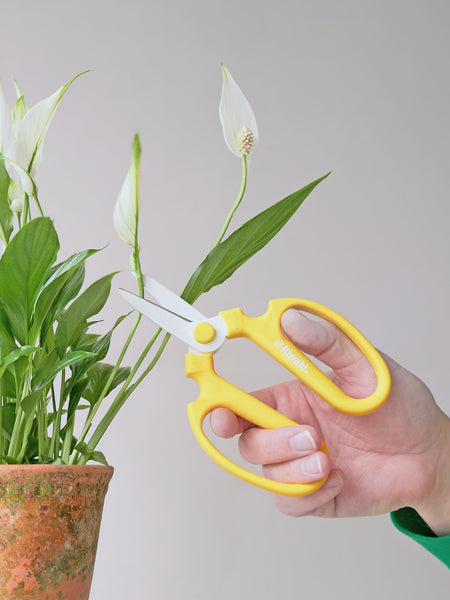Have you ever wished you could quickly and simply display a few flowers without floral foam or a conventional vase? The solution is a flower frog, otherwise known as a kenzan. In this post, I explain what flower frogs are, why they're worth owning and how to use them. You'll also find a demonstration on my YouTube channel:
Flower frogs are reusable, durable holders for cut flowers, transforming the smallest egg cup or largest dish into a vessel fit for a top florist. Originally used for Ikebana, the ancient Japanese art of flower arranging, the ease with which they make cut flowers and foliage come alive in a modern, contemporary way is once again appreciated by all generations.
What is a flower frog?
‘Flower frog’ is a general term for equipment that holds flowers in place in a vessel. Flower frogs can be used with both fresh and dried material. No one knows where the name came from, but let’s assume it’s because they sit quietly below the water's surface, minding their own business. Flower frogs can be a glass or ceramic shape, pierced with holes, or a metal base into which spikes have been embedded. With a glass or ceramic flower frog, stems are inserted into the holes to hold them in position. With a metal flower frog, the base of the stem is usually impaled on the spike or several spikes to hold it fast. (‘Kenzan”, the Japanese name, means ‘mountain of swords’.)
Flower frogs may be round, oval, rectangular or crescent moon-shaped. If you hunt around in flea markets or second-hand shops, you can often find vintage ones. If they are made from steel, they may be a little rusty but still usable. Give them an overnight bath in white vinegar and scrub them with an old toothbrush to remove the worst. Nowadays, flower frogs tend to be made with a base of lead covered with brass pins. Lead provides weight to hold tall stems, and brass is sharp enough to pierce woody stems. Neither metal rusts, so modern flower frogs will last longer than the originals.
Shop Flower Frogs

Vintage flower frogs can resemble instruments of torture or bizarre hair brushes.
What are the advantages of using a flower frog?
The main advantage of a flower frog is that it presents opportunities to use vessels that would otherwise be useless for displaying flowers because they are too shallow or open. A vase typically has a neck that holds stems upright, whereas a bowl, dish or egg cup does not. Flower frogs provide support and the ability to position flowers and foliage precisely, allowing the creation of sculptural, often abstract shapes. Where a vase is flared, you can place a flower frog in the base to keep stems upright and central.
If you only have a few short stems, a flower frog can help you display them artistically - just three, five or seven stems can look like a million dollars. It’s about appreciating the individual forms and colours rather than over-the-top abundance. Once you’ve got the hang of using them, flower frogs are quick to use - when I display them at events, I often get ten minutes to make five arrangements!
Since flower frogs are virtually indestructible, they are vastly more sustainable than floral foam, which readily disintegrates into polluting microplastics and should be avoided. After a modest initial outlay, they quickly pay for themselves if used regularly, making welcome gifts for any garden owner or flower arranger.
A further advantage of using a flower frog in an open bowl is that the flowers will last longer than in an enclosed vase, perhaps one or two days extra. Fewer stems and leaves below the water, combined with good airflow, means that bacteria don’t build up as quickly as they might in a vase - just take care to keep the water level above the top of the brass spikes.
Shop Flower Bowls

Are there any disadvantages to using a flower frog?
Marvellous as flower frogs are, they do have their limitations. Big displays requiring large amounts of heavy material may not be stable enough. They can be secured to the vessel's base using putty or tape, but scrunched-up chicken wire or a metal cage may be a better option in some instances.
To get the best grip, you want to place stems directly on the brass pins, piercing the base of the stem. Some stems are too delicate or may split open when positioned. With these, I leave them until last and let them be supported by tucking them between chunkier stalks.
Flower frogs can be a little tricky to clean if plant material gets trapped between the brass pins. I routinely wash mine in the dishwasher with the pins pointing downwards. If residue remains, I use a wire brush to remove it gently. Bent pins can be straightened using a special pin straightener.
Flower frogs are, of course, sharp, so care should be taken when handling them - it’s not funny if you drop one on a bare foot, which I have done on several occasions!

How do I use a flower frog?
- First, gather your flowers early in the morning or evening and condition them overnight if you can. For more advice, read my guide to cutting and caring for flowers. Don’t worry if your pickings have short or wonky stems - using a flower frog is all about individuality and celebrating natural forms.
- Choose your vessel and a flower frog that will fit comfortably inside. Position it carefully so as not to damage the container or slip when moved. When choosing your frog, consider the height and weight of the stems you’re arranging - a small frog filled with tall flowers may tip over. You can use florists' clay - a malleable green putty - to stick your frog down, if desired. Fill your vessel with cold water to cover the top of the brass pins.
- Now for the fun part! Arranging in a flower frog is a great mindfulness exercise - take your time and don’t feel rushed; enjoy observing each bloom, spray or leaf, considering how you might position it to best advantage. Re-cut each stem before pushing it firmly onto one or more of the spikes, and don’t be afraid to reposition it if it doesn’t look quite right. If a stem splits, recut it and try again - sometimes, cutting below a leaf node where the stalk is thicker will help with this.
- How you arrange the flowers is up to you. Ikebana is a serious art form that takes many years to master. Most of us are content to create something cheerful and uplifting without following rules. However, less is more when using a flower frog. Heed Coco Chanel’s advice about taking one thing off before leaving the house - often, the last stem you place is one too many. And, if you’re basing your arrangement around an intriguing branch or want to show off specific blooms, it’s a good idea to position these first and work around them. If you need inspiration, look no further than #flowerfrog or #kenzan on Instagram.
- Once you’re happy with your display, carefully remove any leaves or stems that clutter the centre of the arrangement and any bits that have fallen into the water. Aim to achieve a clean, simple finish. If you use a shallow bowl or dish and don’t want your flower frog to be visible, use moss or rounded pebbles to disguise it. I sometimes use curled-leaf parsley if I have an excess. The stems will appear as if they are rising naturally from the edge of a stream or pond.
- Finally, position your arrangement somewhere cool and out of direct sunlight to help it last longer. Top the water up if it falls below the level of the brass spikes.

Once you’ve caught the kenzan bug, you’ll appreciate flowers and foliage differently, observing their intricacy and wondering how they might form part of an arrangement. No bloom is too tiny, and delicate wildflowers work wonderfully. I often use weeds or vegetables that have run to seed - you will learn to see them in a very different light. Meanwhile, all those much-loved yet unused noodle bowls, sundae dishes and empty candle jars will suddenly find new purpose as vessels for your creativity. And, if you want to share your newfound enthusiasm for displaying flowers, arranging blooms in a flower frog is a fun activity for a gathering of friends at any time of the year. Ask everyone to bring flowers from their garden and let your imaginations run riot.
